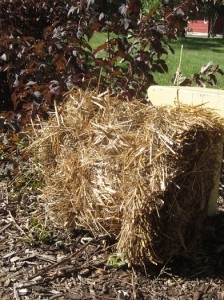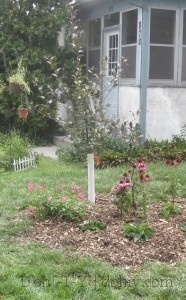Lisa: What a perfect outing for a beautiful autumn day.
Marge: I feel sorry for everyone who’s cooped up inside watching the seventh game of the World Series.
– The Simpsons
I love fall! (And when in the UK, I love autumn.) I’m also quite fond of gardening, so it’s great that there is gardening to do right up until winter. Keeps me off the streets.
If you’re less attached to gardening, you might think, “Enough already!” once summer ends. Even if you look forward to snow, some basic fall maintenance will protect your lawn and garden beds, while promoting bigger, healthier plants next year. (And if you’re in a lovely temperate place where you can garden all dang year…may we come visit in January??)
Flower Gardens
Winterizing your flower beds mainly involves cleaning up dead plant matter around your flowers…and then covering everything up with different dead plant matter.
Wait, what? Yes, that’s right. When plants die, their foliage may contain latent diseases, fungi or bugs. In the spring, those baddies could wake up and cause problems. If you remove dead leaves and then insulate the plant with a different mulch, such as straw or tree leaves, the likelihood of spring issues is reduced. Just like you can’t get your dog’s cold, your flowers aren’t as susceptible to the things that bother grasses and trees.
After the first big freeze kills off foliage, trim back your perennials. If you planted any annuals, such as marigolds or petunias, pull them up as the weather turns cold. You can take all your fall clean-up plant matter to a community compost site or throw them in your own compost pile if you have one. (You can add to your compost pile all winter, as long as you can battle through the drifts to get to it!)
Unless the weather has been wet, give your flower beds a good soak before the ground freezes. Then, after a good ground frost has set in, cover your perennials with four or more inches of mulch.
Some roses and flower bulbs are not hardy and require special treatment over the cold winters; if you are in zone 5 or farther north, look into rose tipping and bulb storage techniques. But hardy shrub roses will get by fine if you pile up mulch or soil over their bases and then cover heavily with straw or leaves. I also do this with my hydrangeas and buddleia.
Another tip for pre-winter flower beds: sketch a plant map. My autumn guide helps me identify new growth in the spring for transplant. Some annuals (Sweet William and cleome, for instance) will readily self-seed, so marking those areas prevents me from accidental overplanting and major confusion.
Trees and Shrubs
As winter wears on, ready food sources become scarce and animals turn to emergency rations. Unfortunately, young trees are on the menu. Rabbits and other understandably hungry marauders chew through the bark to the softer stuff underneath, often killing the tree in the process.
To protect your trees, wrap the trunks with flexible tree wrap, working the material beneath the soil line and wrapping upwards well above the expected snow line. Flexible tubing is another good option – many nurseries even sell saplings with tubing already in place. These protective coats also prevent trees from becoming confused during warm winter days and waking up too early, which can lead to “sun scald” and other growth problems. Tasty shrubs can be defended with chicken wire fences or chemical repellents (not poisons).
Vegetable Beds
Vegetable gardens keep rewarding you well into fall, but when they are done, they’re done. If you grow vegetables, remove and compost any spent plants (leaving any perennials such as asparagus). Over the winter, combat cabin fever by planning next year’s garden menu. Remember that crop rotation is not just for farmers – even in a small vegetable bed, rotate your veggies annually to avoid plant diseases that may develop in the soil.
Lawn
Many gardeners hate grass lawns, conveniently forgetting that a lawn is made of plants. And the plants that make up your lawn also need attention before winter. Unlike other parts of your garden, though, most pre-winter turf maintenance is just an extension of your regular routine.
Keep mowing your grass until it stops growing. Depending on where you are, your lawn may keep going quite late in the year. Remove fallen leaves so the grass can keep gathering energy as long as possible. (Fortunately, leaves are an ideal mulch for your perennials – just move them from grass to garden.) If you have a mulching blade on your lawnmower, you can make light leaf cover into lawn fertilizer just by running over the leaves, but thick mulch layers will not benefit your lawn. The last time you mow, take the grass a little shorter than usual. This removes the juiciest new growth, which might otherwise promote fungal infections.
 Surprisingly, it’s a good idea to fertilize your lawn in the fall. Fertilizing late in the season (late October/early November here in the tundra) gives the lawn a chance to absorb nutrients before going to sleep for the winter. In the spring, it will be ready and raring to go. Follow fertilizer instructions carefully, paying particular attention to application rates – too much of a good thing can kill your grass.
Surprisingly, it’s a good idea to fertilize your lawn in the fall. Fertilizing late in the season (late October/early November here in the tundra) gives the lawn a chance to absorb nutrients before going to sleep for the winter. In the spring, it will be ready and raring to go. Follow fertilizer instructions carefully, paying particular attention to application rates – too much of a good thing can kill your grass.
If this all sounds like too much work, it really doesn’t take all that long, and it’s a good way to enjoy a nice fall day (or two). And it pays off in the spring with an easy start to the growing season.





